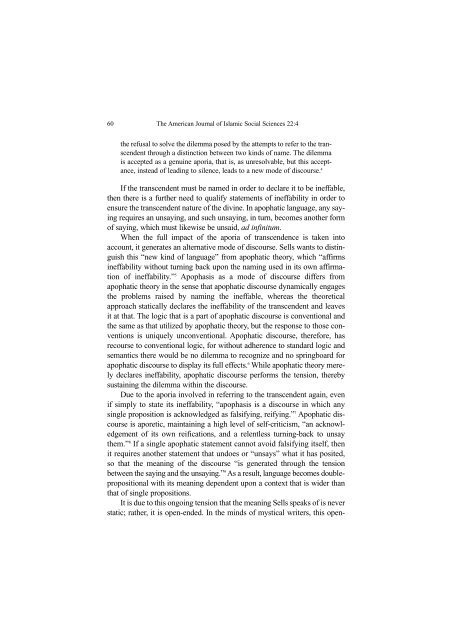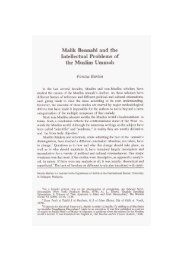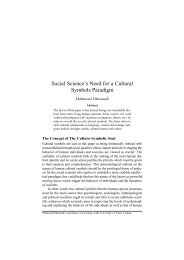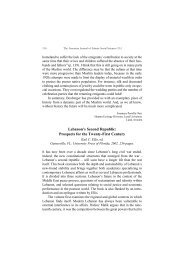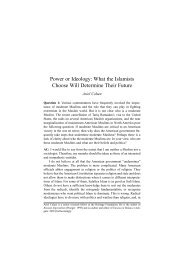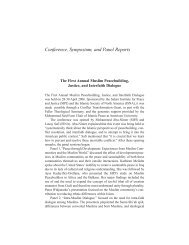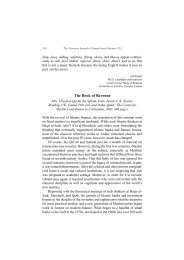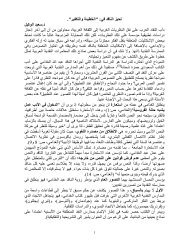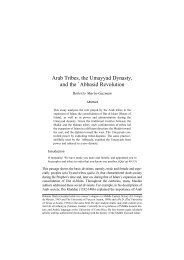Vagueness: An Additional Nuance in the ... - I-Epistemology
Vagueness: An Additional Nuance in the ... - I-Epistemology
Vagueness: An Additional Nuance in the ... - I-Epistemology
You also want an ePaper? Increase the reach of your titles
YUMPU automatically turns print PDFs into web optimized ePapers that Google loves.
60 The American Journal of Islamic Social Sciences 22:4<br />
<strong>the</strong> refusal to solve <strong>the</strong> dilemma posed by <strong>the</strong> attempts to refer to <strong>the</strong> transcendent<br />
through a dist<strong>in</strong>ction between two k<strong>in</strong>ds of name. The dilemma<br />
is accepted as a genu<strong>in</strong>e aporia, that is, as unresolvable, but this acceptance,<br />
<strong>in</strong>stead of lead<strong>in</strong>g to silence, leads to a new mode of discourse. 4<br />
If <strong>the</strong> transcendent must be named <strong>in</strong> order to declare it to be <strong>in</strong>effable,<br />
<strong>the</strong>n <strong>the</strong>re is a fur<strong>the</strong>r need to qualify statements of <strong>in</strong>effability <strong>in</strong> order to<br />
ensure <strong>the</strong> transcendent nature of <strong>the</strong> div<strong>in</strong>e. In apophatic language, any say<strong>in</strong>g<br />
requires an unsay<strong>in</strong>g, and such unsay<strong>in</strong>g, <strong>in</strong> turn, becomes ano<strong>the</strong>r form<br />
of say<strong>in</strong>g, which must likewise be unsaid, ad <strong>in</strong>f<strong>in</strong>itum.<br />
When <strong>the</strong> full impact of <strong>the</strong> aporia of transcendence is taken <strong>in</strong>to<br />
account, it generates an alternative mode of discourse. Sells wants to dist<strong>in</strong>guish<br />
this “new k<strong>in</strong>d of language” from apophatic <strong>the</strong>ory, which “affirms<br />
<strong>in</strong>effability without turn<strong>in</strong>g back upon <strong>the</strong> nam<strong>in</strong>g used <strong>in</strong> its own affirmation<br />
of <strong>in</strong>effability.” 5 Apophasis as a mode of discourse differs from<br />
apophatic <strong>the</strong>ory <strong>in</strong> <strong>the</strong> sense that apophatic discourse dynamically engages<br />
<strong>the</strong> problems raised by nam<strong>in</strong>g <strong>the</strong> <strong>in</strong>effable, whereas <strong>the</strong> <strong>the</strong>oretical<br />
approach statically declares <strong>the</strong> <strong>in</strong>effability of <strong>the</strong> transcendent and leaves<br />
it at that. The logic that is a part of apophatic discourse is conventional and<br />
<strong>the</strong> same as that utilized by apophatic <strong>the</strong>ory, but <strong>the</strong> response to those conventions<br />
is uniquely unconventional. Apophatic discourse, <strong>the</strong>refore, has<br />
recourse to conventional logic, for without adherence to standard logic and<br />
semantics <strong>the</strong>re would be no dilemma to recognize and no spr<strong>in</strong>gboard for<br />
apophatic discourse to display its full effects. 6 While apophatic <strong>the</strong>ory merely<br />
declares <strong>in</strong>effability, apophatic discourse performs <strong>the</strong> tension, <strong>the</strong>reby<br />
susta<strong>in</strong><strong>in</strong>g <strong>the</strong> dilemma with<strong>in</strong> <strong>the</strong> discourse.<br />
Due to <strong>the</strong> aporia <strong>in</strong>volved <strong>in</strong> referr<strong>in</strong>g to <strong>the</strong> transcendent aga<strong>in</strong>, even<br />
if simply to state its <strong>in</strong>effability, “apophasis is a discourse <strong>in</strong> which any<br />
s<strong>in</strong>gle proposition is acknowledged as falsify<strong>in</strong>g, reify<strong>in</strong>g.” 7 Apophatic discourse<br />
is aporetic, ma<strong>in</strong>ta<strong>in</strong><strong>in</strong>g a high level of self-criticism, “an acknowledgement<br />
of its own reifications, and a relentless turn<strong>in</strong>g-back to unsay<br />
<strong>the</strong>m.” 8 If a s<strong>in</strong>gle apophatic statement cannot avoid falsify<strong>in</strong>g itself, <strong>the</strong>n<br />
it requires ano<strong>the</strong>r statement that undoes or “unsays” what it has posited,<br />
so that <strong>the</strong> mean<strong>in</strong>g of <strong>the</strong> discourse “is generated through <strong>the</strong> tension<br />
between <strong>the</strong> say<strong>in</strong>g and <strong>the</strong> unsay<strong>in</strong>g.” 9 As a result, language becomes doublepropositional<br />
with its mean<strong>in</strong>g dependent upon a context that is wider than<br />
that of s<strong>in</strong>gle propositions.<br />
It is due to this ongo<strong>in</strong>g tension that <strong>the</strong> mean<strong>in</strong>g Sells speaks of is never<br />
static; ra<strong>the</strong>r, it is open-ended. In <strong>the</strong> m<strong>in</strong>ds of mystical writers, this open-


